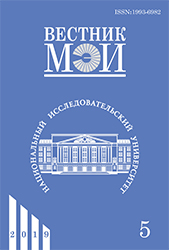Электротепловая модель и режимы работы индукционной тигельной печи с проводящим ферромагнитным тиглем
DOI:
https://doi.org/10.24160/1993-6982-2019-5-91-100Ключевые слова:
индукционная тигельная печь, ферромагнитный проводящий тигель, электротепловая модель, электрические характеристикиАннотация
Разработана нелинейная математическая модель, основанная на методе конечных элементов, для расчета электрических и тепловых характеристик индукционной тигельной печи с проводящим ферромагнитным тиглем. Изучены электрические характеристики печи в зависимости от частоты, температуры и тока индуктора. Решена нестационарная тепловая задача. Математическая модель реализована в пакете ELCUT.
Выделены и исследованы три режима работы печи, характерных для плавки металлов: холодный, когда температура ферромагнитного тигля ниже температуры точки Кюри (723 °С), а загруженный в него металл представляет кусковую шихту; переходный, когда температура тигля ниже точки Кюри, а металл внутри жидкий; горячий, когда температура тигля выше точки Кюри, а тигель немагнитный. Получены зависимости активного сопротивления и индуктивности системы «индуктор – загрузка» от частоты, температуры и тока в среде Simulink/Matlab.
Разработан экспериментальный стенд, состоящий из индукционной тигельной печи с ферромагнитным проводящим стальным тиглем, высокочастотного регулируемого транзисторного источника питания, микропроцессорной системы управления и системы сбора данных. Проведен эксперимент на лабораторной печи со стальным тиглем с загрузкой из алюминиевого сплава. Результаты эксперимента хорошо совпадают с результатами математического моделирования, что подтверждает адекватность математической модели.
Библиографические ссылки
2. Фарбман С.А., Колобнев И.Ф. Индукционные печи для плавки металлов и сплавов. М.: Металлургия, 1968.
3. Установки индукционного нагрева / под ред. А.Е. Слухоцкого. Л.: Энергоиздат, 1981.
4. Sassa Kensuke, Kuwabara Mamoru, Yasuda Tadayoshi, Asai Shigeo. Experimental Measurements and Theoretical Analysis of Induction Heating by Use of a Conductive Crucible // Tetsu-To-Hagane J. Iron and Steel Institute of Japan. 1991. V. 77. Iss. 9. Pp. 1442—1449.
5. Szkliniarz W., Szkliniarz A. The Characteristics of TiAl-based Alloys Melted in Graphite Crucibles // Materials Sci. and Techn. 2017. No. 12. Pp. 1—9.
6. Patidar B., Hussain M., Jha S., Sharma A., Tiwari A. Analytical, Numerical and Experimental Analysis of Induction Heating of Graphite Crucible for Melting of Non-magnetic Materials // IET Electric Power Appl. 2017. V. 11. Iss. 3. Pp. 342—351.
7. Кувалдин A.Б., Федин M.A., Кулешов A.O., Жмурко И.Е. Разработка релейных систем управления мощностью и температурным режимом индукционных тигельных печей с использованием физического моделирования // Форум научных материалов. 2017. Вып. 906. С. 8—15.
8. Федин M.A., Кувалдин A.Б., Кулешов A.O., Генералов И.M. Экспериментальное исследование физической модели индукционной тигельной печи и разработка системы управления // XI Междунар. форум по стратегической технологии (IFOST): Сборник трудов. Ч. 2. Новосибирск, 2016. С. 68—72.
9. Федин М.А., Кувалдин А.Б., Кулешов А.О. Выбор методики расчета и исследование электрических характеристик индукционных тигельных печей с проводящим тиглем // Вестник МЭИ. 2017. № 3. С. 77—86.
10. Кувалдин А.Б. Индукционный нагрев ферромагнитной стали. М.: Энергоатомиздат, 1988.
11. Федин М.А., Кувалдин А.Б., Кулешов А.О., Жмурко И.Е., Ахметьянов С.В. Расчет и исследование электрических характеристик индукционных тигельных печей с немагнитным проводящим тиглем // Всеросс. науч.-практ. конф. по экологии и безопасности в техносфере: актуальные проблемы и решения. 2018. Т. 115. Вып.1.
12. Волков Е.А. Численные методы. М.: Физматлит, 2003.
---
Для цитирования: Федин М.А., Кувалдин А.Б., Кулешов А.О., Ахметьянов С.В., Кондрашов С.С. Электротепловая модель и режимы работы индукционной тигельной печи с проводящим ферромагнитным тиглем // Вестник МЭИ. 2019. № 5. С. 91—100. DOI: 10.24160/1993-6982-2019-5-91-100.
---
Работа выполнена при поддержке: Министерства науки и высшего образования Российской Федерации (инициативный научный проект № 8.9608.2017/БЧ)
#
1. Vaynberg A.M. Induktsionnye Plavil'nye Pechi. M.: Energiya, 1967. (in Russian).
2. Farbman S.A., Kolobnev I.F. Induktsionnye Pechi dlya Plavki Metallov i Splavov. M.: Metallurgiya, 1968. (in Russian).
3. Ustanovki Induktsionnogo Nagreva. Pod Red. A.E. Slukhotskogo. L.: Energoizdat, 1981. (in Russian).
4. Sassa Kensuke, Kuwabara Mamoru, Yasuda Tadayoshi, Asai Shigeo. Experimental Measurements and Theoretical Analysis of Induction Heating by Use of a Conductive Crucible. Tetsu-To-Hagane J. Iron and Steel Institute of Japan. 1991;77;9:1442—1449.
5. Szkliniarz W., Szkliniarz A. The Characteristics of TiAl-based Alloys Melted in Graphite Crucibles. Materials Sci. and Techn. 2017;12:1—9.
6. Patidar B., Hussain M., Jha S., Sharma A., Tiwari A. Analytical, Numerical and Experimental Analysis of Induction Heating of Graphite Crucible for Melting of Non-magnetic Materials. IET Electric Power Appl. 2017; 11;3:342—351.
7. Kuvaldin A.B., Fedin M.A., Kuleshov A.O., Zhmurko I.E. Razrabotka Releynykh Sistem Upravleniya Moshchnost'yu i Temperaturnym Rezhimom Induktsionnykh Tigel'nykh Pechey s Ispol'zovaniem Fizicheskogo Modelirovaniya. Forum Nauchnykh Materialov. 2017;906: 8—15. (in Russian).
8. Fedin M.A., Kuvaldin A.B., Kuleshov A.O., Generalov I.M. Eksperimental'noe Issledovanie Fizicheskoy Modeli Induktsionnoy Tigel'noy Pechi i Razrabotka Sistemy Upravleniya. XI Mezhdunar. Forum po Strategicheskoy Tekhnologii (IFOST): Sbornik Trudov. Ch. 2. Novosibirsk, 2016:68—72. (in Russian).
9. Fedin M.A., Kuvaldin A.B., Kuleshov A.O. Vybor Metodiki Rascheta i Issledovanie Elektricheskikh Kharakteristik Induktsionnykh Tigel'nykh Pechey s Provodyashchim Tiglem. Vestnik MEI. 2017;3:77—86. (in Russian).
10. Kuvaldin A.B. Induktsionnyy Nagrev Ferromagnitnoy Stali. M.: Energoatomizdat, 1988. (in Russian).
11. Fedin M.A., Kuvaldin A.B., Kuleshov A.O., Zhmurko I.E., Akhmet'yanov S.V. Raschet i Issledovanie Elektricheskikh Kharakteristik Induktsionnykh Tigel'nykh Pechey s Nemagnitnym Provodyashchim Tiglem. Vseross. Nauch.-prakt. Konf. po Ekologii i Bezopasnosti v Tekhnosfere: Aktual'nye Problemy i Resheniya. 2018;115;1. (in Russian).
12. Volkov E.A. Chislennye Metody. M.: Fizmatlit, 2003. (in Russian).
---
For citation: Fedin M.A., Kuvaldin A.B., Kuleshov A.O., Akhmet′yanov S.V., Kondrashov S.S. The Electrothermal Model and Operating Modes of an Induction Crucible Furnace with a Conducting Ferromagnetic Crucible. Bulletin of MPEI. 2019;5:91—100. (in Russian). DOI: 10.24160/1993-6982-2019-5-91-100.
---
The work is executed at support: Ministry of Science and Higher Education of the Russian Federation (Initiative Research Project No. 8.9608.2017/БЧ)




